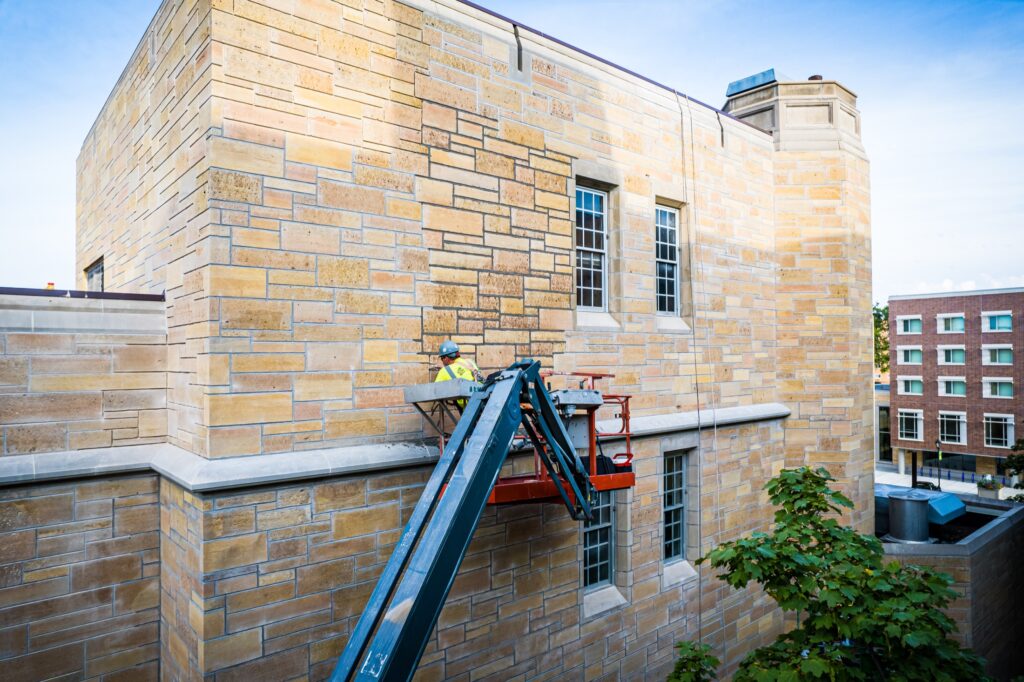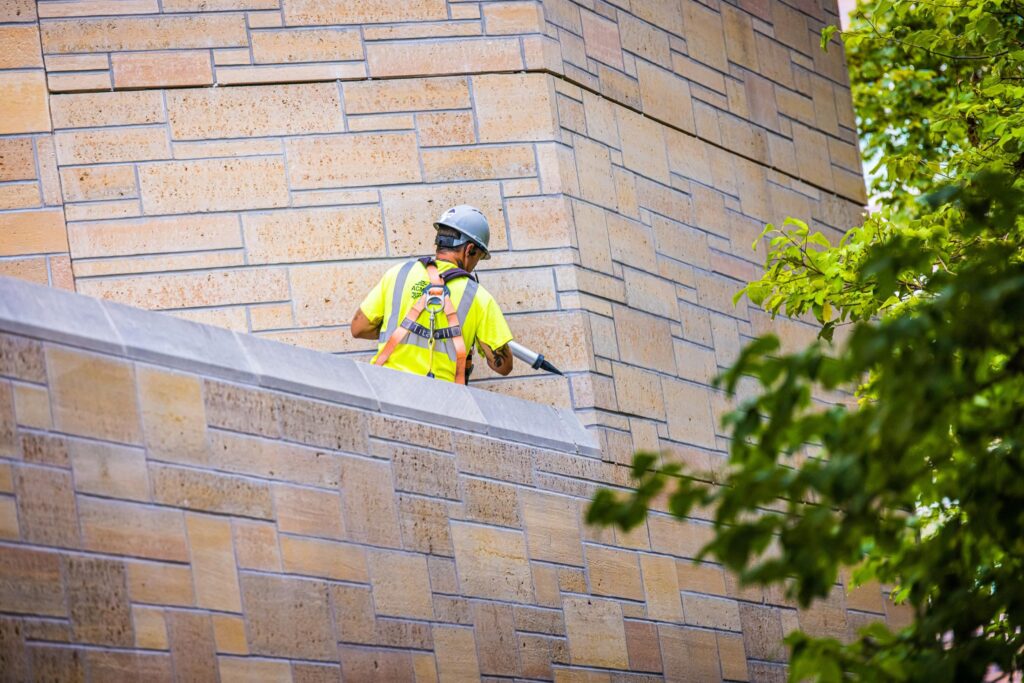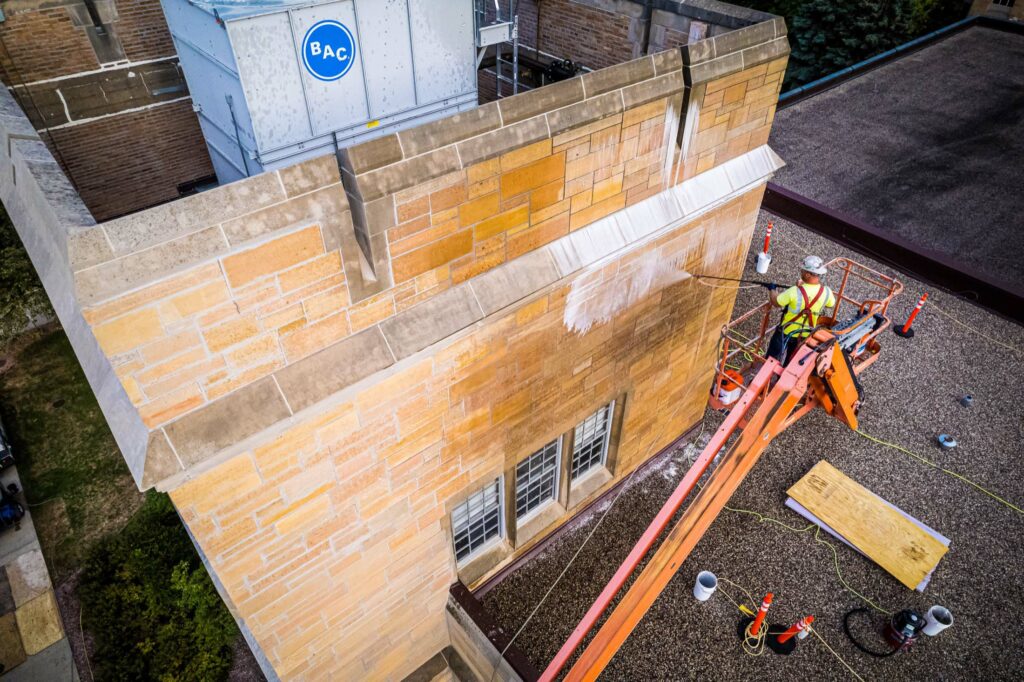Looking for expert help with your masonry work?
At ACME Tuckpointing & Restoration, we can help with that. From tuckpointing to caulking, we can take care of your maintenance needs to give your building the structural integrity it deserves.
What is Tuckpointing?
Tuckpointing is the process of cutting out old mortar to a uniform depth and placing new mortar in the joint is used to repair mortar joints that have deteriorated.
Mortar joints are considered deteriorated when:
- Eroded back more than 1/4" from the face of the unit or beyond the depth of the original joint.
- Cracks are visible within the mortar.
- The bond between brick and mortar is broken or the mortar is soft and/or crumbling.
- Any portion of a mortar joint is missing.
The deterioration of mortar is caused by any (or all) of the following factors:
- Excessive moisture entering a wall and freezing repeatedly. As frozen water expands, this leads to spalling of the mortar and brick. The sources of moisture entry (beyond normal exposure) include leaks in flashing, gutters, lintels, sills, and sealant joints.
- Older buildings commonly built without adequate expansion joints. This leads to cracking when building movement, from thermal expansion, is not provided for. All clay products (brick) grow in long term service while concrete products shrink.
- Uneven settlement in a building's foundation ,which can result in cracking.
- The composition of the mortar being unable to be resistant to severe weathering (more predominant in very old buildings). For example, the use of high cement content mortars can result in loss of bond between brick and mortar.
- Erosion from water, wind, and pollution.

The Tuckpointing Process
Professional tuckpointing involves these steps:
- Identification of wall area(s) in need of repair.
- Removal of the defective mortar with the proper tools to prevent damage to adjacent masonry units.
- Removal of dust and debris from joints to be pointed by brushing or flushing with water.
- Mortar is mixed that closely matches the existing in strength, hardness, color and texture.
- Dampening of the mortar joints before the mortar is pointed in.
- Tightly packing the fresh mortar into the joints in thin layers (1/4" maximum).
- Tooling of the mortar to match the original profile after it has become “thumbprint” hard.
- Light brushing of the joints to remove any excesses.
- Application of commercial cleaners to remove any mortar stains.
Once a wall area has been properly tuckpointed, it not only has improved structural integrity, but it’s more resistant to moisture penetration for years to come. An added benefit of tuckpointing and brick maintenance? The overall appearance of the wall is enhanced with new mortar in place.

Replacement
As confined moisture freezes, it also expands. When excess moisture freezes within brick or concrete block, the result oftentimes is the cracking, spalling or disintegration of these units.
Deteriorated brick or block should be identified and replaced with new units that closely match the original in size, color and texture. We recommend repairing any conditions that expose the masonry to abnormal moisture. This will help prevent the same deterioration occurring in the future, and is an important part of masonry maintenance.
Caulking
Missing or deteriorated sealant within building expansion joints and at the perimeter of masonry openings (windows, doors, etc.) is often the source of moisture entry into the wall system.
Sealant failures result from:
- Improper joint design (width of joint)
- Incorrect type of sealant used (i.e., silicone, urethane, acrylic)
- Lack of proper preparation, including cleaning and priming prior to sealant installation
- Incorrect placement of backing rod (the material behind the sealant used to control its depth or width-to-depth ratio)
- Age and exposure to ultraviolet light from the sun and climatic extremes
These joints should be professionally inspected. If the sealant has torn or lost elasticity, it should be cut out completely and new sealant properly installed.

Through-Wall Flashing
When properly designed and constructed, masonry walls effectively resist moisture. However, excess moisture may develop within the wall system if an effective means of relieving the absorbed moisture is not used.
The result of this can lead to the corrosion of masonry anchors, lintels and relieving angles, water damage to interior finishes, and the creation of mold or mildew on the non-masonry surfaces. The installation of through-wall flashing allows for the removal of excess moisture from masonry wall systems when not originally included in a building's construction.
When, by inspection, it is determined that through-wall flashing would provide the necessary correction for these problems, the suitable material will be selected. We give thoughtful consideration to durability, compatibility and ease of installation, as well as cost. Flashing is typically designed for installation at window and door lintels, and continuously along the relieving angles between building floors. There are many options available when specifying a through-wall flashing material and a satisfactory balance between budget and performance can be achieved.
All flashing will then be installed according to corresponding industry guidelines. Once in place, it will provide an effective means of expediting accumulated moisture from a building's masonry wall system for years to come.
Cleaning
The accumulation of dirt and pollutants on masonry, to say nothing about graffiti and vandalism, can cause damage to a building's overall appearance. Cleaning would also be required if coating of the masonry surface is completed.
The masonry can be cleaned to its original color or tone with the use of restoration cleaners and high-pressure water. With the number of environmentally-friendly cleaners from different manufacturers available, it’s easy to select the best product for your masonry maintenance.
Water Repellants
Masonry structures, when properly constructed and maintained, are quite resistant to moisture penetration by themselves. Added protection may be obtained through the application of high-quality water repellents.
Although not designed to prevent all instances of moisture penetration, they do aid in lessening the amount of water absorbed into the masonry wall systems. However, the effective use of these materials requires that the masonry be in good condition, without cracks or other deterioration.

Estimated Life Expectancy of Materials Exposed to Normal Weathering
| Material | Use | Estimated Life Years |
| Brick
Caulking Metal Mortar Plastic |
Walls
Sealer Coping/Flashing Walls Flashing |
100 or more
8-10 20-40 25 or more 25 or more |
| Finishes | ||
| Sealers
Silicone Paint |
Damproofing
Damproofing Waterproofing |
1 - 5
1 - 5 3 - 5 |
